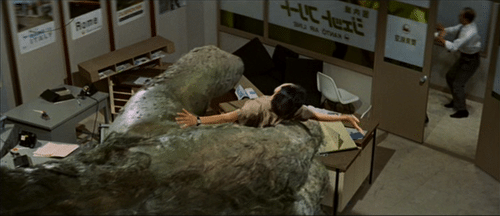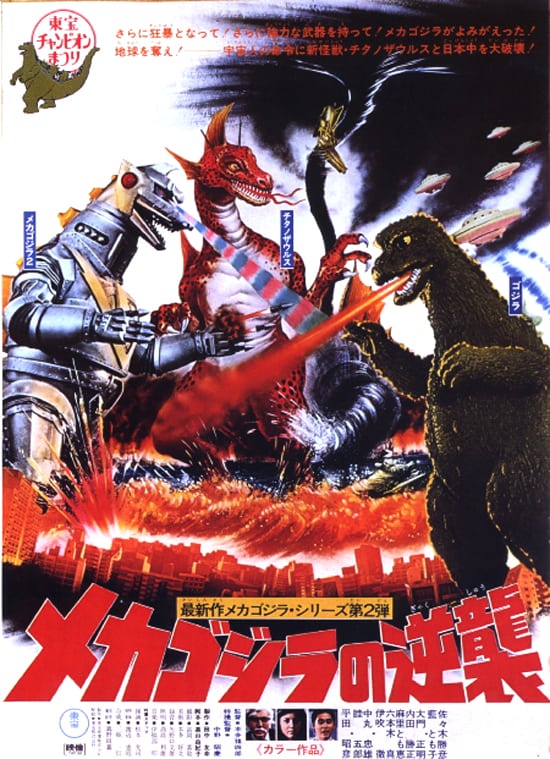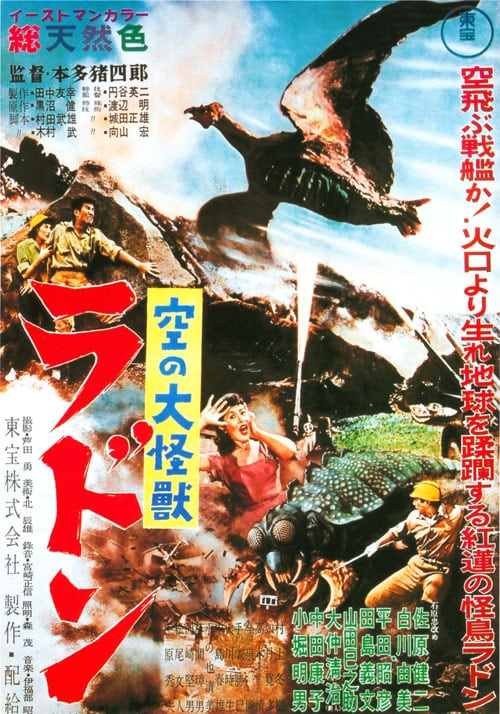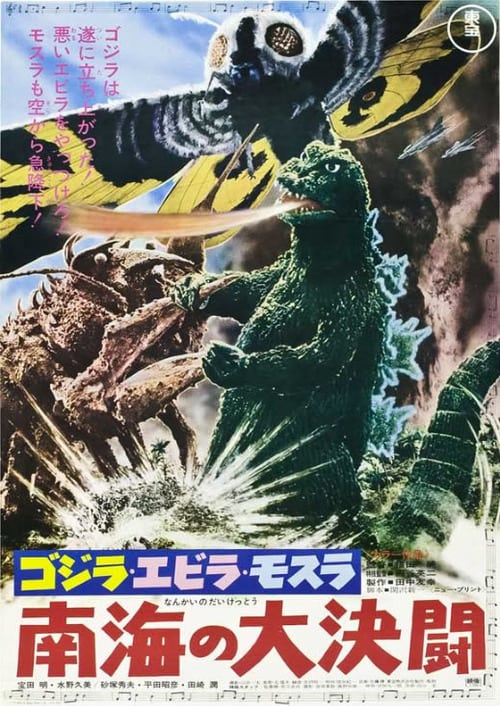The War Of The Gargantuas (1966)
Directed by: Ishirô Honda
Written by: Ishirô Honda, Reuben Bercovitch, Takeshi Kimura
Starring: Kenji Sahara, Kumi Mizuno, Nobuo Nakamura, Russ Tamblyn
HCF REWIND NO.128: WAR OF THE GARGANTUAS aka FURANKENSHUTAIN NO KAIJU: SANDA TAI GAIRA, FRANKENSTEIN MONSTERS: SANDA VS GAIRA [Japan 1966]
AVAILABLE ON DVD
RUNNING TIME: 90 min/ 92 min [US version]
REVIEWED BY: Dr Lenera, Official HCF Critic
A giant octopus attacks a ship until Frankenstein, now green, appears to defeat it, then eats the crew except for one sole survivor who tells his tale to the disbelieving authorities. The press pick up on the story and interview Dr. Paul Stewart and his female assistant, Akemi, who once had the creature in their possession for study five years prior before it escaped. This had been a gentle creature and lived in the mountains rather than the ocean, so it seems unlikely that is the same monster, who surfaces to destroy another boat, while, at the same time, a mountain guide sees a similar brown giant up in the Japanese Alps. It seems there are two ‘Gargantuas’……
Yes, Frankenstein is now green and looking very different for this sequel to Frankenstein Conquers The World, but then if you’ve only seen the American version, which removed all references to the previous film, you probably wouldn’t have been aware that this was a sequel to an earlier movie. In any case, The War Of The Gargantuas is considerably better than its predecessor and easily the best non-Godzilla monster movie Toho made in the second half of the 60’s. Unlike the other two monster efforts Toho made in collaboration with UPA of America [the non-Frankenstein one being Invasion Of Astro-Monster], which dragged at times and didn’t really deliver enough of what most people came to see them for: city-stomping monster action, The War Of The Gargantuas is constant excitement from beginning to end, its flimsy plot nothing more than an excuse to link together as much creature footage as possible. The down side of this is that the humans are almost lost in all this, and even more than before, director Ishiro Honda is finding it very difficult to insert any subtext or message. All this movie is really about is two giants tearing up Japan, but if that’s not enough for you then you’ll never get into these films at all!
As before, Reuben Bercovitch wrote a treatment which Takeshi Kimura expanded into a screenplay. His original ending, with the underwater volcano that erupts destroying Tokyo, was un-filmed due to cost. Toho’s profits were slightly dwindling and they were beginning to find ways to save money. Nick Adams from the other two Toho/UPA pictures was busy shooting another film, so UPA head Henry P. Saperstein rustled up another American ‘star’; Russ Tamblyn, who had been fairly popular in the late 50’s/early 60’s but whose career was now dipping. Honda had to shoot some scenes twice and even some extra footage to beef up Tamblyn’s part for the US version, while the actor also had to loop himself for those scenes which removed the Frankenstein references. Tamblyn was dubbed by another actor for that for Toho’s ‘official’ English language version, which was dubbed [badly] in Hong Kong rather than the Japanese-based Frontier Enterprises. This version, which didn’t have the extra Tamblyn footage, was released in UK cinemas, while the re-edited US version,with all the Frankenstein references removed, didn’t come out till 1970, when it did good business doubled billed with Invasion Of Astro-Monster. There were plans for a sequel called Godzilla Vs. The Gargantuas; sadly, this never came about.
You can understand why UPA pretended this wasn’t a sequel to Frankenstein Conquers The World, because in its original version, it’s really inconsistent. If Tamblyn’s character is obviously supposed to be the one played by Adams, and Kumi Mizuno’s the same one she previously played, then why do they have different names? Even more oddly, why does the young creature in the flashback look nothing like the Frankenstein we know; he’s hairy and makes a noise like a chimpanzee? And why do people immediately think the green giant is Frankenstein right at the beginning of the picture, despite not looking much like him? When we eventually do meet the ‘actual’ Frankenstein, because, as you’ve probably realised, the destructive green monster is not him at all [he’s some kind of mutation from him], he’s changed substantially too, and is now called Sanda! O well never mind, it’s best not to think about all this, and continuity issues become far worse with the Godzilla series later on!
The action gets going right away with the octopus attacking the ship, and, if your preferred version of Frankenstein Conquers The World is the one which ends with Frankenstein dragged into the water by a giant octopus, then you could pretend this is the same critter. He looks much better now, convincingly slimy and with his tentacles moving realistically. The scene is also slightly scary, and in fact the film has more of a horror element than the proceeding film, what with the way Gaira the green Gargantua eats people – in one scene he is seen chewing up a female victim, even if logically he would have trouble doing this because some of his teeth point away from the mouth – and the really grotesque look of Sanda and Gaira, Gaira especially looking horrible in close-up with his nightmarish face which looks like that of a medieval devil crossed with that of a gorilla. These creatures move fast too, even running at times, and their mobility is refreshing, as is being able to see the performer’s own eyes rather than ping-pong balls. This is just as well, because they on are onscreen for a huge amount of time, with Gaira destroying ships, most of an airport, battling the military [his two best bits are when he destroys some houses by throwing tanks at them, and when he runs down a street treading on cars] and finally fighting Sanda. This battle doesn’t take place in the usual countryside or deserted locale but right in Tokyo, so buildings crumble as the monsters fight, and fight, and fight. The climactic volcano eruption just seems a too-convenient way to kill off the monsters though.
The special effects aren’t always up to the standard of early 60’s Toho, with the Gargantuas seeming to change size at times, but the minutely detailed miniature landscapes, with near-perfect sky backdrops that for once are often unnoticeable, are special effects master Eiji Tsuburaya’s best. What does let things down somewhat are the endless scenes of military mobilisation, seemingly there to try to compensate for the film’s virtual lack of a plot, but going on far too long, and the lack of both chemistry and characterisation [except for Mizuno] involving the humans. Tamblyn’s character is far more laid-back than Adams’s, but the actor doesn’t help with his ‘can’t really be bothered’ performance, barely reacting to what’s happening around him, even when Akemi is in danger. At least Mizuno is as bright as normal, certainly doing the best she can with the limited screen time her character is given. Sanda’s King Kong-like crush on her results in him saving her twice, while she desperately wants to stop him being killed. Her look of despair right at the end, having failed to stop the creature perishing, is quite powerful, especially as this was the last film Honda would make with his favourite leading lady. As for Honda himself, his personal touch may have been lessening as the films were increasingly giving him less room for social commentary or messages, but he still proves himself capable of handing an action-orientated monster spectacular.
Constant Toho monster movie star Kenji Sahara seems bored with his weakly written role, but Jun Tazaki retains dignity in the second-to-last of the many times he played a military captain. Akira Ifukube’s score, with its two monster themes combining together elements of his Frankenstein and Baragon themes, and a particularly catchy [if over-used] march, is fairly strong, though the most unforgettable musical instance is when the action is briefly interrupted for a certain Kipp Hamilton, credited as ‘special guest star’ in the US version, to ‘sing’ a daft song called The Words Get Stuck In My Throat. I don’t know what is worse, her warbling or the ridiculous lyrics, but it certainly adds even more crazy entertainment value to the film. There’s no depth whatsoever to The War Of The Gargantuas, but its rush to give us loads of exactly what we want is admirable and, if that’s not enough for you, at the 84th Academy Awards last year, Brad Pitt mentioned it as one of the first films that made an impression on him.
Rating: 









It’s very interesting comparing this with the original version [as usual, you can do this on the R1 DVD]. The removal of the Frankenstein references, in a film which was very shaky as a sequel, actually helps matters, though Tamblyn re-dubbing some of his own lines is very obvious. The addition of a couple of extra minor scenes and the re-shooting of some footage means that his character is introduced into the film a few scenes earlier, appearing in a couple of situations he didn’t in the Japanese version, though of course this means that there’s more of his flippant performance. Elsewhere, a few alternate takes are used here and there, such as the Gaira spitting out of flowers replaced by the clothes of the woman he’s just eaten. The music was mucked about with considerably, sometimes in a good way, sometimes not. The total removal of Ifukube’s march for the military means that you miss a good theme, but the Philip Green-composed piece, a cue which appeared in many American science-fiction films of the 50’s called ‘Terror Hunt‘, which replaced it does increase the pace of those overlong army scenes. Sometimes bits of this piece appear elsewhere and alternate with Ifukube’s music. It’s odd how they obviously didn’t like one particular short fight motif heard with other material, so they just re-edited the music so it didn’t appear. They also added tiny bits of Invasion Of Astro-Monster music throughout and, annoyingly, the Godzilla/Rodan and Ghidorah themes from that film near the end. Overall, this version does work well, to the point that you could say that the best edit of this film would combine bits from both.









Be the first to comment